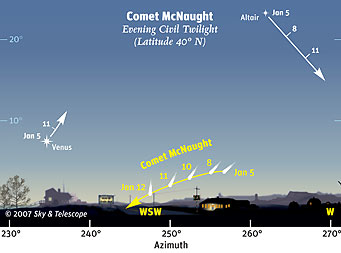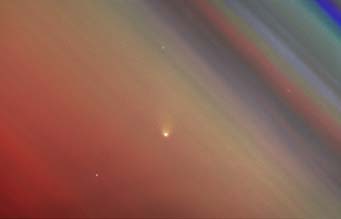
Using binoculars, look for Comet McNaught 20 to 40 minutes after sunset. The bright sky may swamp most of its tail, leaving just a point of light. Venus, and possibly Altair, can guide you to the comet's location. Click above for a larger version of this diagram.
Sky & Telescope diagram.
A major comet, known as Comet McNaught or C/2006 P1, is right now making its way through the inner solar system. It’s already as bright as the brightest stars, but it is also sticking close to the glare of the Sun. For this reason the general public won’t be gathering on street corners to gaze at it, as they did Comet Hyakutake (in 1996) or Comet Hale-Bopp (1997). But amateur astronomers in north-temperate latitudes, with their observing know-how, have an excellent chance of spotting Comet McNaught in the next week or so, very low in the bright glow of evening twilight, with the aid of the diagram at right.
People with Go To scopes can obtain R.A. and Dec. from the Minor Planet Center. Note that the data is given for 0h Universal Time, which corresponds to evening on the previous day in North America. So if you're on Mountain Standard Time, which runs seven hours earlier than UT, and you're looking for the comet at 5 p.m. on January 8th, then the ephemeris for January 9th will be exactly correct.
Robert H. McNaught discovered this unexpected visitor last August 7th with the 20-inch Uppsala Schmidt telescope on Siding Spring Mountain in Australia. It was then in Ophiuchus and much fainter than Pluto, but calculations at the Minor Planet Center soon showed that it would brighten dramatically. It was inward bound toward perihelion on January 12th, due to pass just 0.17 astronomical unit from the Sun (half Mercury’s distance). But it has recently been lurking beyond the Sun, as seen from Earth, so the prospects for a bright comet were difficult to assess until the start of this year.

Austrian astrophotographers Jaeger and Rhemann captured Comet McNaught an hour before sunrise on December 30, 2006. More photos.
Michael Jaeger and Gerald Rhemann
Far-northern observers were among the first to spot the comet visually in binoculars and small telescopes. On December 29th, Bjorn H. Granslo in Fjellhamar, Norway, glimpsed the 4th-magnitude, tailless object in his 4-inch refractor. Near Duluth, Minnesota, Bob King found it in his 10-inch reflector on the morning of January 2nd. “I will not soon forget this kernel of a comet in a pale blue sky,” he posted to the Yahoo comets mailing list. By next morning, John Bortle in Stormville, New York, judged it “not fainter than 2nd magnitude” in 15x80 binoculars.
How bright will Comet McNaught get? Complicating any guesstimates is the fact that it passes almost between Earth and Sun. For example, Joseph N. Marcus has assessed the degree to which the comet’s gas and dust will forward-scatter sunlight in a paper posted on Astrosite Groningen. He concludes this enhancing effect could help the comet reach magnitude –3 to –5, about as bright as Venus!
At this writing, for high-latitude observers, the comet is equally easy to spot both before dawn and after sunset. (Make that equally difficult.) After January 6th it becomes mainly an evening target. But no matter where you live it stays lower than Venus in the bright twilight throughout the next week or so, as shown in the diagram above.
Observers at tropical latitudes will have an even harder time keeping up with this comet; for them its path runs closer to the evening twilight horizon. Right after mid-month, however, it becomes visible to those living at the southern latitudes of Australia, South Africa, Argentina, and Chile. The comet will climb in their evening sky toward month’s end, but by then it will be fading fast.
 0
0
Comments
You must be logged in to post a comment.